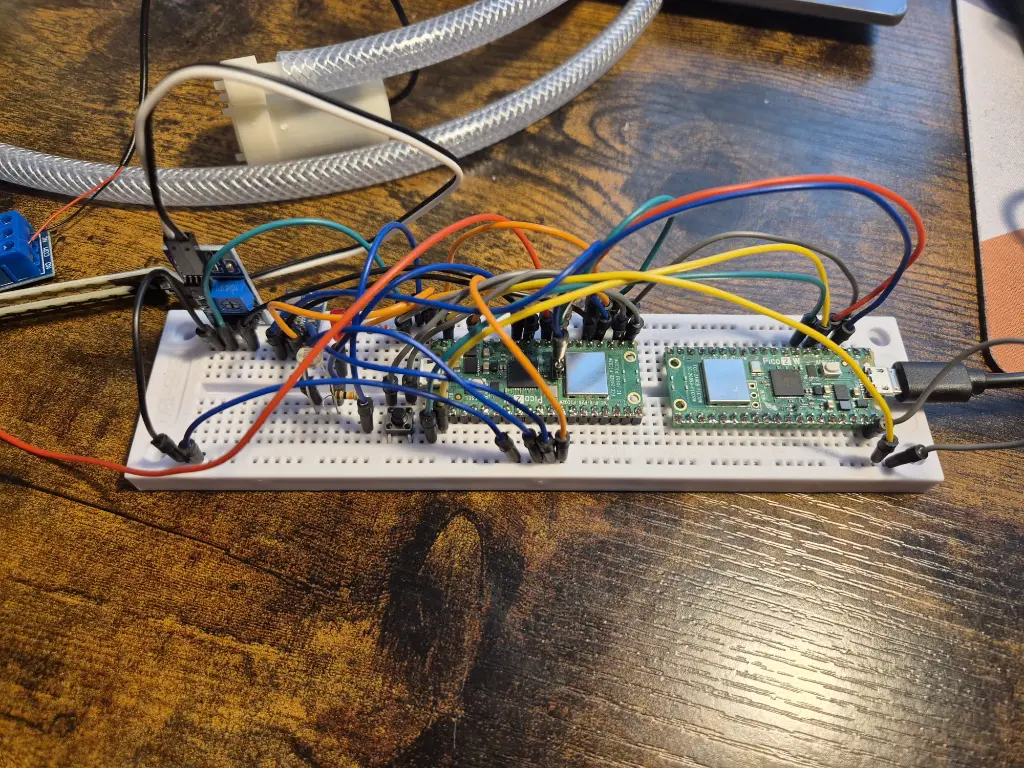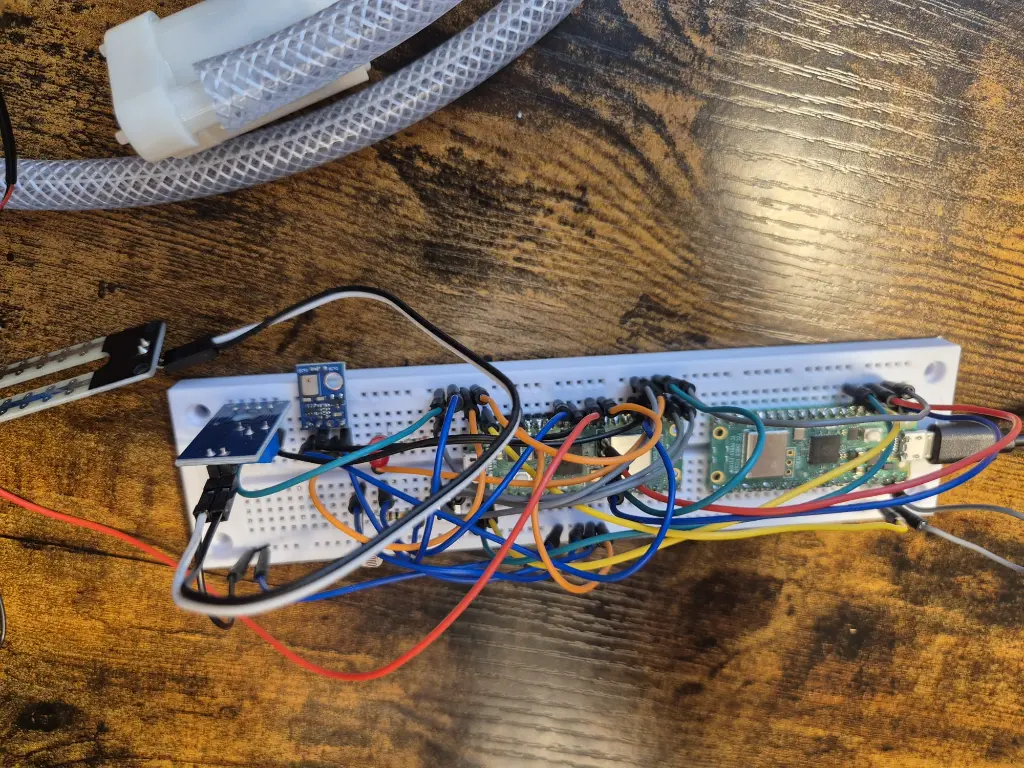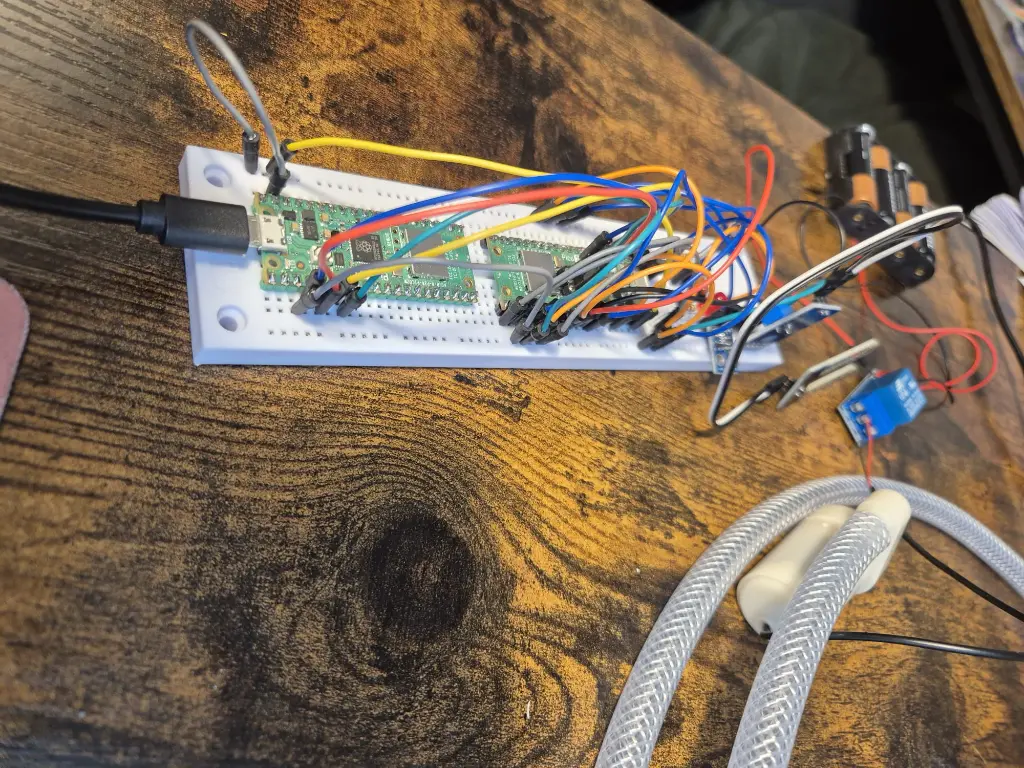Plant Friend
This project is about taking care of your plants (even if you sometimes forget about them). It has quite a lot of sensors, monitoring aspects about temperature, humidity, light, and soil moisture, and it can water the plant when needed.
Author: Ionescu Petru-Vlad
Github Project Link: https://github.com/UPB-PMRust-Students/proiect-vladiouz
Description
The project is using a Raspberry Pi Pico 2W board, which is connected to the sensors and the water pump. Based on all the data collected, the project can determine if the plant needs to be watered or not. Additionally, the user can turn off the auto-watering functionality by a press of a button. In critical conditions, a red LED will start flashing. Using Wi-Fi, the project can send the data to a web server, where the user can see the data in real time.
Motivation
I have quite a few plants at home and I often forget wattering them, which is quite a shame (basically I wanted to create something that I would really use). My grandma also loves flowers and I think this project will make her happy.
Arhitecture
The following components were used:
- soil moisture sensor, that provides both digital and analog output. I will use the analog output to get good precision. For this, the sensor will be connected to an ADC capable pin of the board, namely pin 26.
- water pump, which will be put under water and will be connected to a relay in order to be controlled.
- one-channel relay, connected with the water pump and a GPIO pin of the board. I will choose pin 22 for this.
- AHT10 humidity and temperature sensor, which is I2C capable. I will connect it to pins 18 and 19 of the board.
- photoresistor, which will send data about light intensity. I will connect it to pin 27 of the board, being an ADC capable pin.
- button for toggling auto-watering mode. I will connect it to pin 16 of the board.
- red LED for signaling a critical state of the plant. I will connect it to pin 17 of the board.
- Raspberry Pi Pico 2W board, which will be the main component of the project. It is connected directly to (almost) all the other components and will also be used for its Wi-Fi capabilities.
Weekly Log
Week 24 April - 1 May
Wrote project documentation, including all components and connections needed. Finalized the hardware scheme in KiCad.
Week 1 May - 8 May
Wired 90% of the hardware. Also accidentally burnt one of the Picos while connecting the soil moisture sensor. Wrote the code for initializing all the periferics + reading data from the AHT10. Updated the KiCad schematics, having a small issue (one PIN badly connected). Updated the bill of materials.
Week 8 May - 15 May
Wired correctly hardware, some complications with wiring the batteries, relay and water pump (could not get it done at the lab). Found the issue with the soil moisture sensor and solved it. Updated KiCad. Next up is writing up the software.
Week 15 May - 22 May
Hardware done, software wrote and tested, working as expected. Next up is PM Fair.
Hardware design
Description of hardware used: The Raspberry Pi Pico 2W is the central component of the project. It is connected to all the sensors and the water pump (indirectly). The sensors where chosen based on pricing and performance, so measurements would be accurate and useful. The water pump is used to water the plant when needed, and the relay is used to control it. The red LED is used to signal a critical state of the plant, while the button is used to toggle the auto-watering functionality.
Schematics





Bill of materials
95% of the hardware has been purchased from Optimus Digital:
| Description | Quantity | Unit Price (RON) | Total Price (RON) |
|---|---|---|---|
| Raspberry Pi Pico 2W | 3 | 39,66 | 118,98 |
| AHT10 High-Precision Digital Humidity and Temperature Sensor | 1 | 14,99 | 14,99 |
| 0.25W 10KΩ Resistor | 3 | 0,10 | 0,30 |
| 0.25W 4.7KΩ Resistor | 2 | 0,10 | 0,20 |
| Soil Humidity Sensor Module | 2 | 3,99 | 7,98 |
| Photoresistor (5528 type) | 2 | 1,49 | 2,98 |
| 6x6x6 Button | 1 | 0,36 | 0,36 |
| HQ Breadboard (400 Points) | 1 | 4,56 | 4,56 |
| Fire Set for Breadboard | 1 | 7,99 | 7,99 |
| 5V Single-Channel Relay Module | 1 | 4,99 | 4,99 |
| Mini Submersible Water Pump | 1 | 9,99 | 9,99 |
| Colored Wires Male-Female (10p) 10 cm | 1 | 2,99 | 2,99 |
| Red 5mm LED | 1 | 0,39 | 0,39 |
| 0.25W 220Ω Resistor | 2 | 0,10 | 0,20 |
| Black Micro USB Cable 1m | 1 | 3,99 | 3,99 |
| Green 2.54mm Pin Header (40p) | 2 | 0,99 | 1,98 |
| Colored Female-Female Wires (40p) 10 cm | 1 | 6,99 | 6,99 |
| Breadboard (750 points) | 1 | 8,98 | 8,98 |
| Red 3mm LED | 4 | 0,39 | 1,56 |
| Colored Female-Male Wires (10p) 20 cm | 2 | 3,99 | 7,98 |
| Battery holder 4 x R6 | 1 | 9,43 | 9,43 |
| 1N4007 Diode | 2 | 0,49 | 0,98 |
| Duracell AA5 | 1 | 24,99 | 24,98 |
| 6mm Hose (1m) | 1 | 4,17 | 4,17 |
| Total | 246,97 |
Software design
The program will periodically check the sensors values and will determine if the plant needs to be watered or not. It will use an algorithm based on soil moisture, temperature, light and air humidity. The user will be notified on the frontend regarding the health status of the plant. Toggling the button will change the auto-watering functionality, so the relay will or will not activate the water pump.
The software repository also contains the server and the frontend client. Data is send each second from the Pico 2W to the TCP server and back.
Regarding the software libraries:
| Library | Description | Usage |
|---|---|---|
| embassy-rp | HAL for Raspberry Pi | ADC, Channel, I2C and GPIO functionalities. |
| embassy-sync | no-std, no-alloc synchronization primitives with async support | Communication using Signal |
| embassy-time | Working with time in embassy | Setting timers |
| embedded-hal-async | async Hardware Abstraction Layer for embedded | I2C communication |
| itoa | integer primitive to string conversion | serializing data to be sent over TCP |
| static_cell | Statically allocated, initialized at runtime cell | For RESOURCES during Wi-Fi configuration |
| embassy-net | Async TCP/IP network stack for embedded systems | Wi-Fi |
| embassy-futures | no-std, no-alloc utilities for working with futures | yield_now for button and LED |
| embassy-executor | async/await executor designed for embedded usage | Spawning to be executed almost simultaneously |
| cyw43 | Rust driver for the CYW43439 WiFi chip, used in the Raspberry Pi Pico W | Wi-Fi |
| defmt | Logging framework for embedded systems | Used for logging and debugging |
| defmt-rtt | Real-Time Trace (RTT) support for defmt. | Enables logging output over RTT |